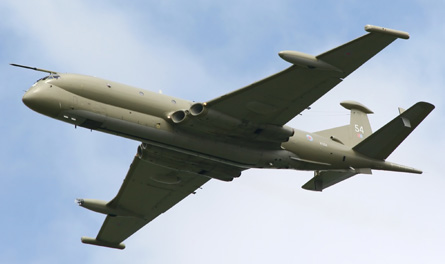The UK Royal Air Force is to restrict operations of its British Aerospace Nimrod MR2 and Nimrod R1 surveillance aircraft fleets for the next several months, following a decision to complete essential safety modifications to the aged types.
Announced by armed forces minister Bob Ainsworth on 9 March, the action means that the RAF will have no Nimrods deployed in support of operations in the Middle East - including over Afghanistan - between no later than 31 March and the "early summer". Required modifications include replacing engine bay hot air ducts and fuel seals in 15 MR2s (one pictured below) and three R1s, according to the RAF.
 |
|---|
© Dragon Lady gallery on flightglobal.com/AirSpace |
"These programmes were due to complete by 31 March but, unfortunately, problems with the provision of replacement fuel seals mean that both programmes will be delayed beyond that date," says Ainsworth. "In order that the risks involved in operating the aircraft remain tolerable and as low as reasonably practicable, no Nimrods should fly after 31 March, unless their hot air ducts have been replaced.
"Our priority now is to ensure that we modify the remaining aircraft as quickly as possible, so we are temporarily withdrawing Nimrod aircraft from overseas operations until early summer. This will allow us to free up the maximum number of aircraft for the modification programme, while also allowing Nimrod to continue with its critical homeland security tasks." However, Ainsworth confirms that the work will "cause a temporary reduction in routine UK-based Nimrod flying".
The RAF says six of its aircraft will have received the improvements by the end of this month, while one industry source reveals that the entire fleet is expected to have undergone the work by the end of this year.
Nimrod MR2s have been heavily employed in the overland surveillance role since operations began in Afghanistan in 2001, with the three-strong Nimrod R1 electronic intelligence fleet also having supported UK and allied forces. Ainsworth says deployed operations will be supported using "other UK and coalition assets to maintain an effective surveillance capability" in the absence of deployed Nimrods.
Meanwhile, the MoD says Qinetiq has produced the second report under an audit of the Nimrod fleet, and that this "does not identify any significant airworthiness issues. The findings of the report do not alter previous assessments that the Nimrod aircraft remains safe to fly subject to the measures outlined above," it says.
Scrutiny of the RAF's Nimrod fleets has been intense since a September 2006 mid-air explosion over southern Afghanistan which destroyed MR2 XV230 and killed 14 service personnel. The accident was attributed to factors including leaking fuel coming into contact with super-heated bleed air pipes routed from the type's engines.
Source: Flight International



















